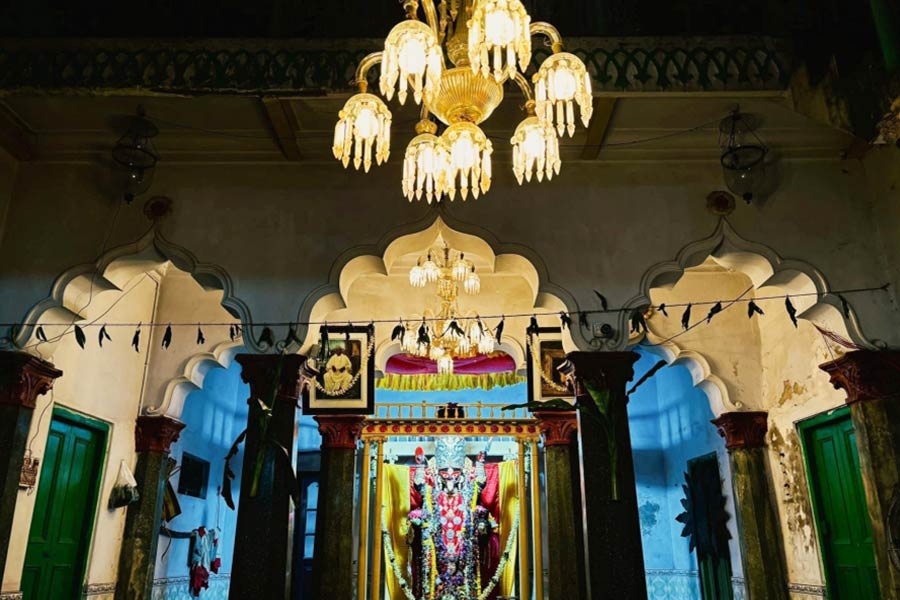Kali Puja is also often referred as Shyama Puja, as the deity worshipped in Bengali household is Dakshina Kali and Shyama Kali is another version of this deity. The rituals are similar but the skin tone of Shyama Kali is bluish, whereas that of Dakshina Kali is pure black. The deity of the Pramanick family of Simulia (Simla) Kansaripara in the lane adjacent to Srimani Market on Bidhan Sarani in north Kolkata is essentially Dakshina Kali with a black skin tone.
It is mentioned in the family tree of the Pramanick family of Simulia Kansaripara printed in a worn-out paper dated 5th Ashwin 1337 (20th September 1930) that the seven households of their family in unison had been worshipping goddess Kali over 300 years. So the resultant puja is well over 400 years at present.

The ‘Saatghar Pramanick’ family conducts ‘dhuno porano’ rituals during Kali Puja
Interestingly, these families are not of seven biological brothers but seven households related to each other which is why they are jointly known as ‘Saatghar Pramanick’. According to one of the members, Chandrasekhar Pramanick, the family originated from Bardhaman.
The Kali Puja used to place in some other parts of the locality performed by local Kangsabanik community, which was ultimately shifted to the Pramanick’s residence. It is said that a daughter-in-law of the family saw a young girl of dark complexion enter the house as the sound of her nupur (decorative anklet worn by women) could be heard distinctly. It was an indication that the goddess intended to settle at this abode.
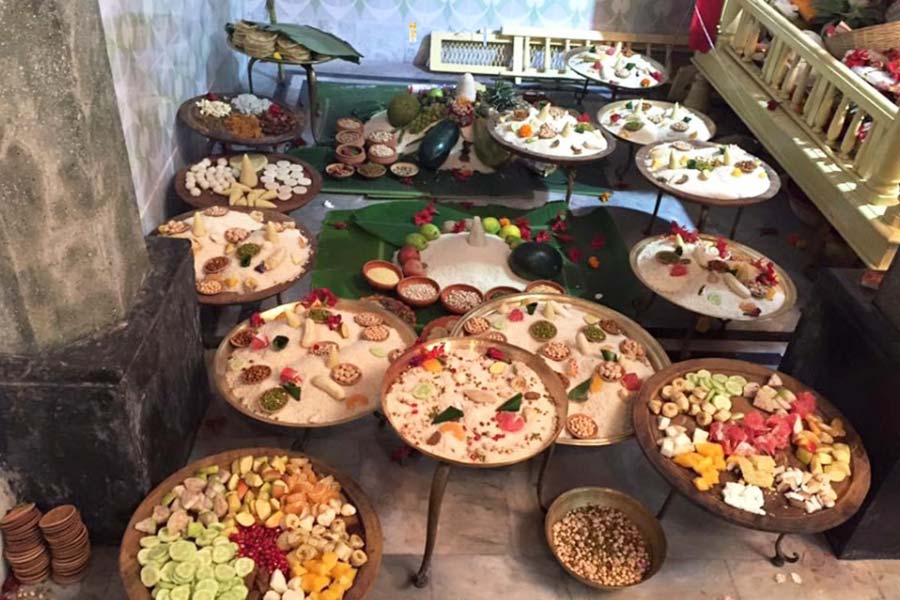
Food offering to goddess Kali at the residence of the Pramanicks at 37A Tarak Pramanick Road in Simla off Bidhan Sarani
The deity is initially decked up in daaker saaj, which is primarily made up of rangta (silver foil) and silver sequins. The day before Kali Puja, the goddess is seated on an intrinsically designed wooden throne positioned on the three-arched thakur dalan (inner courtyard) adorned with chandeliers. Under the throne, a pile of earth is stacked, which family member Chanda Pramanick claims to be age-old, probably from the distant past when the puja was started. Before the deity sits on the throne, a handful of paanch korai (five kinds of sprouts) and paddy soaked in water are thrashed into that pile of earth in a painstaking process. Cow dung and cow urine are also added. The sprouts and the paddy grow up into plants at a later date. A simple alpona or decoration is made using powdered rice grains.
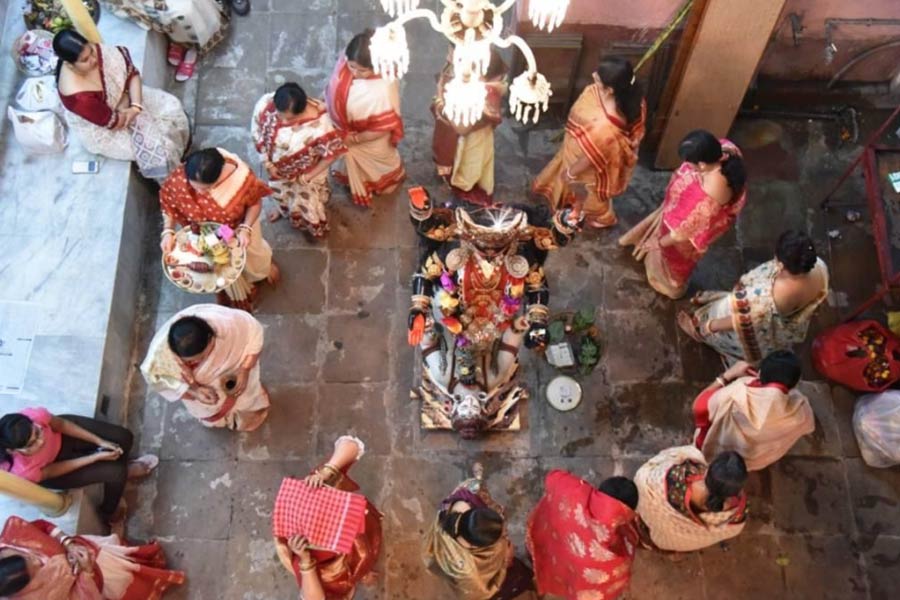
Married women encircle the goddess during ‘thakur baron’ rituals on Dashami
On the day of puja, daaker saaj is removed and the goddess is adorned with jewellery made of gold and silver, all of which are family heirloom. A large silver crown is place on the head of the goddess and the khnara placed on her left upper hand is made of Silver. Interestingly, a small khnara made of gold can be seen on her same hand fitted on the silver khnara.
The goddess remains adorned with these jewellery till the end of puja when thakur boron takes place. Before immersion, the deity is again adorned in daaker saaj and she is taken to the banks of the Hooghly in this attire.

Earthen lamps lit in front of the idol of goddess Kali
The mangal ghot (holy urn) of Kali Puja is made of copper. The priest paints a coloured design around it on the floor of the thakur dalan. Inside the ghot, small rings of silver having a small quantity of gold in it, square-shaped elements of silver known as aasan and pancha ratna are placed along with pancha pallab {leaves of banyan, ashok, ashvattha, mango and yagga dumur (cluster fig)} trees.
The baron dala or the offering tray includes several items offered to the goddess. The item is generally more or less the same but differs in some items in different households.
In the Pramanick family of Simulia Kansaripara, the items placed on the baron dala comprises dried paddy, sindur chubri (bamboo container decorated with cowrie or shells) containing a comb, a small mirror and a sindur container, small piece of earthen mush and mush made of rice grains (mushes replacing a piece of stone in this house), paanch korai (sprouts), pancha sashya (five types of foodgrains), yellaki banana, turmeric, cowrie, belerics, supari, catechu (kattha or khayer), cardamom, maskalai, reetha for hair, kajal lata (made of iron) for eye decoration, altapata, shakha for feet decoration, shankha, pala, noya (signs of a married woman), scented water, scented oil and soap.

The idol of Kali at ‘Saatghar Pramanick’ is first decked up in ‘daaker saaj’ a day before Kali Puja, those are removed on the day of Kali Puja, she is adorned with jewellery owned by several family members and (right) the deity again gets decked up in ‘daaker saaj’ for immersion Photograph courtesy: Arjyamik Das (left) and Arpita Pramanick (right)
The baron dala is accompanied by a kulo (bamboo tray of a particular shape) containing four earthen pots (Mangal Hari), each filled with seddho chaal, supari, turmeric, cardamom (big and small), besides a cowrie. The ingredients are usually mixed with turmeric powder in five portions. The fifth portion is kept on the kulo separately. The pots are tied with red thread to prevent the contents from spilling over. The contents of the kulo are then covered with a gamcha.
The goddess is offered several saris. Also, dhuti and uttoriyo are offered of which one is for Shiva and other for Narayana. On the day of Kali Puja, the priest brings his own Narayan deity for worship at Pramanick family as well the Dhannolaksmi of the family (who is worshipped throughout the year) is also worshipped in the thakur dalan.
Making a special arghya (offering to the goddess) is an important part of household Kali Puja.
Here, at the Pramanick family residence, 108 doob grass along with 100 unbroken grains of rice are wrapped inside a large piece of cotton and tied with a red string which is later smeared with vermilion. A single such package of cotton comprises arghya in the Kali Puja of the family. Usually, after the puja, arghya is kept with the family members but members of Pramanick family of Simulia Kansaripara provide small portions of arghya to devotees who ask for it. It has been proven to be beneficial.
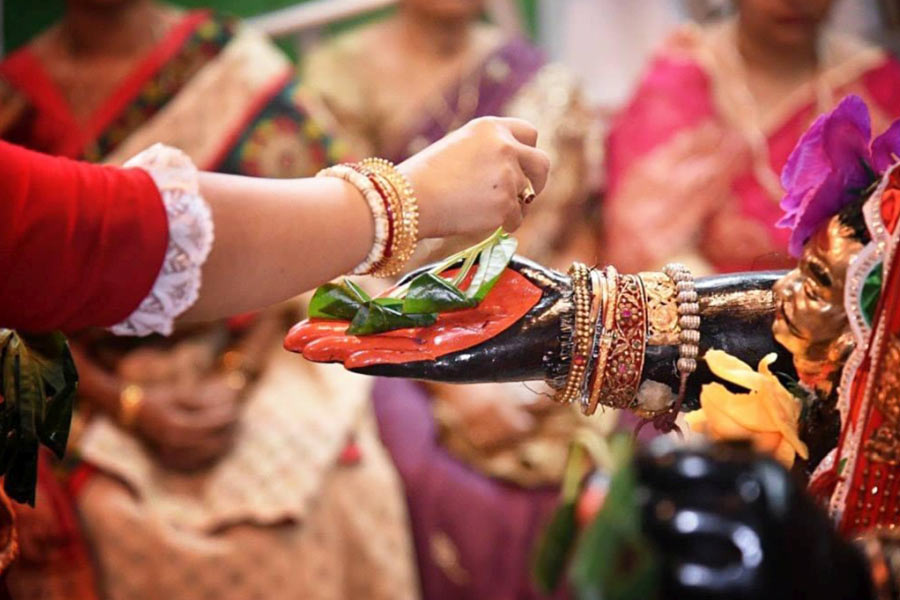
‘Jharkhali paan’ offered to Kali during rituals of ‘thakur boron’ on the day of immersion
After the main puja of the goddess is completed with the usual offerings and services in Shodashopachara mode, 108 earthen lamps are lit and placed in front of the goddess on the thakur dalan. This follows a home yagna ritual. Thereafter, dhuno porano rituals take place on the courtyard in front of the thakur dalan. Many devotees come to the Pramanick house performing dandi rituals. After dhuno porano, the pushapanjali ritual (flower offering to the goddess) follows.
Usually, karon or liquor offered to the goddess is an important ingredient of the Kali Puja. However, in the Kali pujo of the Pramanick family, liquor is provided by the priest, while the family members provide siddhi (a drink made from leaves of the cannabis plant).
The Kali idol is immersed on the same day when the puja is completed. Usually, the Puja starts late at night and is completed the following day in the early hours.
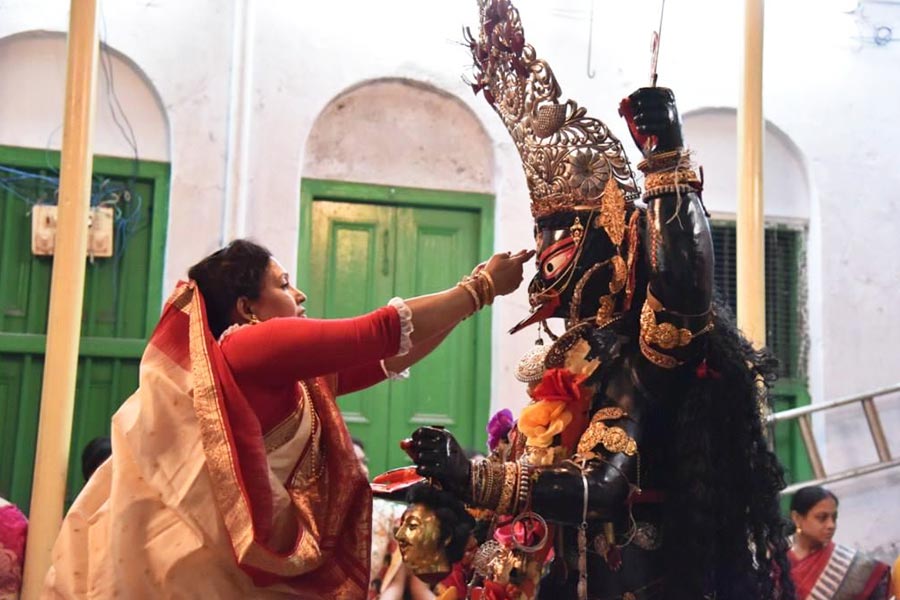
A woman performs ‘baron’ rituals on Dashami at the residence of Pramanicks
The food offering to the goddess includes 16 to 17 types of naibedya (offerings of rice, bananas, sweets, coconut mandas (a type of sweets) accompanied by paan khilis. Apart from this, panch kalai, five types of fruits, and soaked chickpeas are offered. Luchi is offered to the goddess with five types of fried vegetables and sandesh made of notun gur. Before the puja starts, two brand new plates are kept in front of the goddess. One consists of uncooked rice, sweets and water and other consists of unrefined sugar and sweets. A daab is cut and offered to the goddess along with a full portion of curd in an earthen pot.
Earlier animal sacrifice used to take place in the Pramanick household. It has been stopped since long and at present no sacrifice takes place (even fruits and vegetables are not sacrificed.)
The family members follow a vegetarian diet seven days prior to the puja; and conduct the ritual of Baron on the day of immersion of the Goddess. The Goddess is offered Jharkhili Paan and sweet before her departure. Earlier, the Goddess used to be carried manually to Hooghly for immersion along with 50 lathiyals , but now it is taken by a transport. After immersion of the deity, it is customary to consume Siddhi Sherbat by family members.
Chanda Pramanick said that even at this date, children of the house have many a times claimed to hear the sound of nupur inside the house.
